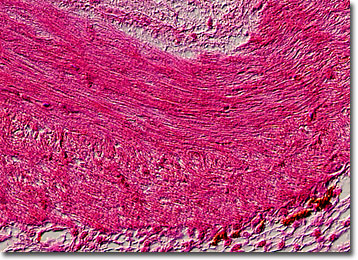Differential Interference Contrast Image Gallery
Frog Heart Muscle Tissue
Frogs are tailless amphibians that belong to the order Anura. Species of frog may vary greatly in size, behavior, and habitat, but they all have something in common; the same kind of blood and the same type of heart that pumps it through their bodies.

Unlike most mammalian species, frogs and other amphibians possess nucleated blood cells, which is an indication of their less evolved nature. Moreover, their circulatory systems feature a heart that has only three chambers, rather than the four possessed by humans and other more advanced species. The combination of two atria and a single ventricle complicates circulation because blood returning to the heart from the lungs is combined with incoming blood from the body, resulting in mixing between oxygenated and deoxygenated blood. Frogs handle this situation, however, by having a very slow metabolism and by absorbing some oxygen through their skin. There is also some directional control of the distribution of blood flow by the ventricle.
In order to carry out their daily activities, frogs depend upon three types of muscle; striated (skeletal), cardiac (heart), and smooth. Striated muscles are composed of elongated fibers and are used for actions such as hopping. As indicated by the name, the tissue exhibits striped or striated patterns when examined under a microscope. Smooth muscle cells, on the other hand, are usually smaller than striated ones and have a distinctly different appearance. Allied with autonomic or involuntary systems, smooth muscle tissues can be found in the digestive system, the blood vessels, and a large number of the internal organs. Cardiac muscle, however, is a highly specialized component of the heart, which appears similar to striated muscle, but functions involuntarily in a manner comparable to smooth muscle.
